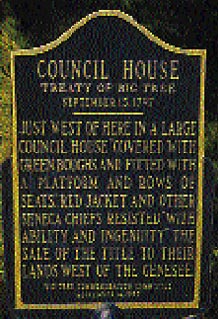
Genesee Country Magazine
Greatest Hits
Search Our Website!
 |
Genesee Country Magazine | Search Our Website! |
Related
Links: | GC Magazine Home | GC Greatest Hits | Clarion Publications | WNY Travel Guide |
Treaty of Big Tree |
 |
A plaque commemorating the Big Tree Treaty was placed this year near the Geneseo village park where the 200-year-old treaty was signed. |
It is important to understand that the Senecas, and indeed the Iroquois, had a long tradition of negotiation going back to about 1690, when they stopped trying to maintain their middleman status in the fur trade and started playing the French and British off against each other. Their theory was that the Europeans represented the balance of power in the area now known as New York. This balance was pivotal for each country in their aspirations for American empire. Presents were showered on the Senecas by each side: both were always in doubt as to the Indians' true loyalties.
When things quieted down the following day, thanks to the smashing of the unauthorized whiskey barrel, Farmer's Brother opened the council by saying they were willing to answer. With that, Red Jacket intervened, saying that, since they had been unable to find out what price was being offered, he hoped Morris would continue to “hold his fists closed” because they would rather have their lands than his money.
That night, Morris began meeting with the friendlier Indian leaders, telling them he was offering $100,000 for their land. They told him to make the offer in public council, not privately.
Red Jacket saw Morris privately also, saying he was still open to conviction, and was not as opposed as his speeches indicated. But at the next day's public meeting, Red Jacket reminded his compatriots that they would not be a great people if they sold their lands, and insisted that any offer be put in writing “since memories are short.”
Morris made his offer public, as advised, and added that he would be glad to put it in writing. He stressed how many horses it would take to bring $100,000 in silver coins, and warned that if the Indians did not accept, his father would not make another offer. He also implied that he didn't know how settlers could be kept out of the area.
Cornplanter said he hoped the Senecas would not waste any more time, or give Morris no satisfaction. Commissioner Wadsworth then said that he, for one, was not pushing the Indians to sell, but that he regretted “a division in the Indian's council.”
Farmer's Brother said they were not in disagreement, but if they were, it was none of the white man's business. Things were getting testy.
On Sept. 3, the “troublemakers” scored again with their whiskey, and one of them was arrested and sent to jail in Canandaigua. Who were these troublemakers? Some were probably only whiskey salesmen, but others, doubtless, were squatters already settled on Indian land, afraid that their “titles” would be jeopardized if the formal land conveyance was approved.
When the council reconvened the following day, Red Jacket suggested testing the land's value and offered to sell Morris a 6 mile square piece of land at the southeast corner of the total parcel for $1 an acre. He said Morris would make enough profit from this to pay at least the cost to him of feeding the treaty attendants.
Pressed by his impatient white colleagues, Morris angrily said, in effect, “If that's all you're willing to do, we might as well cover the council fire and go home.”
“This is the point to which we wanted to bring you,” Red Jacket said, quickly kicking dirt over the fire and shaking Morris's hand. The council dissolved in uncertainty. Not a small amount of private consultation occurred that night.
In the morning, apparently after receiving the advice of Cornplanter and Farmer's Brother, Morris asked that the tribe's headwomen be brought to meet with Col. Wadsworth. There, Morris explained his offer to the women in glowing terms, contrasting the benefits the money could convey with the poverty they were then suffering, and distributing some gifts to buy their good will.
He explained that he had lit the council fire and that by their custom only he could extinguish it. He said the headwomen and warriors could override a contrary decision made by the tribe's sachems. The women, impressed and anxious to come away with something, spent the next day in consultation and in the exercise of pressure.
According
to WebCounter you are the
person to answer the Clarion Call
©2008 Clarion Publications, Inc. All
Rights Reserved.
This site designed by Clarion Communications.